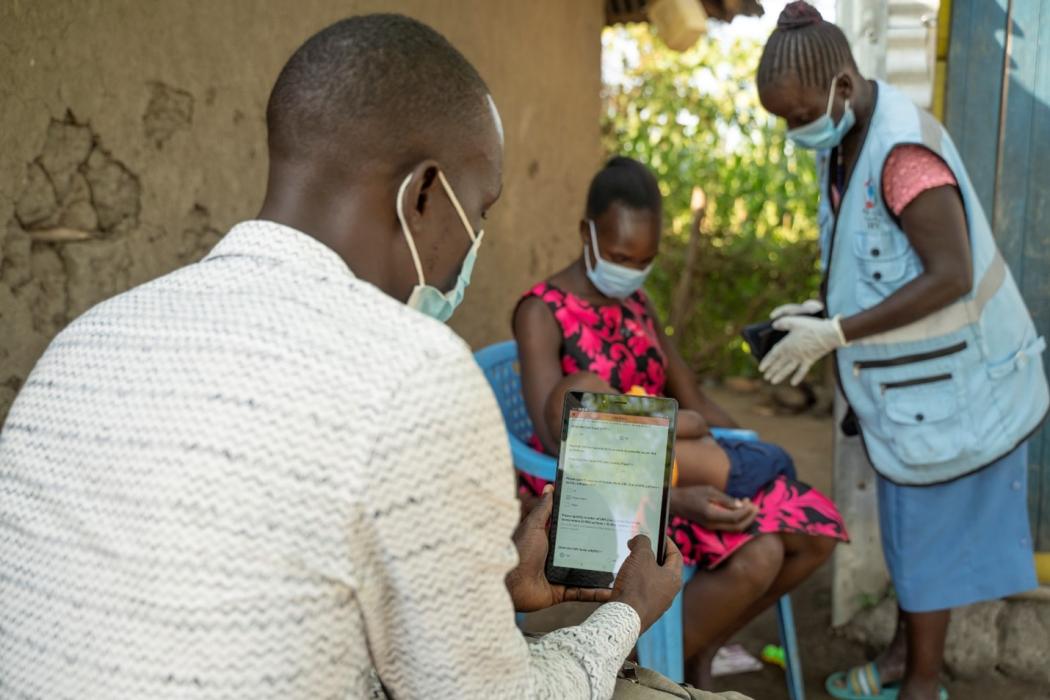COVID-19 and Digital Transformation for Health Systems

Kenyan community health supervisor uses a tablet to enter data during a field visit with a community health worker (CHW) at a client’s home. Living Goods, a Frontline Health Workers Coalition member, partners with county governments in Kenya to digitally enable supervisors and utilize data to track and improve CHW performance. Photo courtesy Living Goods.
On the quest for high-impact interventions to save lives, many decision-makers, implementers, and donors look to digital technologies and tools. Over the past decade we have been searching for and developing tools to transform the way frontline health workers deliver health care to reach more people with quality and affordable services. Despite the best of intentions, our undertakings as the digital health community have led to a plethora of pilots that often ended up in a ‘virtual graveyard’ after a short time in use.
When reflecting on why health systems around the world haven’t experienced a comprehensive digital transformation, I look at the environment they function within. The ways people seek and receive health care and the ways providers deliver care have been primarily static over the past decade. If we are to see true digital transformation of health systems, we need a cultural transformation to happen first.
Shifts in culture are notoriously hard. Something big needs to happen—something that cannot be ignored for behaviors, patterns, and systems to change. For digital health, the COVID-19 pandemic was just that, acting as a trigger that disrupted the cultural inertia of health systems, health workers, and people. It was—and currently still is—a catalyst forcing health systems to change core cultural levers including around policy and partnerships.
Over the last year and a half, everyone—including community health workers (CHWs)—connected with the health sector was forced to learn and adapt rapidly to changing circumstances. Data became a high-value resource to inform key decisions we needed to flatten the curve of the pandemic. We also saw health care policies around the world evolve to approve vaccines in record time and make virtual care and telemedicine more accessible. Ministries of health are exploring transformative partnerships through inviting ministries across sectors, private-sector partners, and nonprofits to support and jointly design new services and products with them. Policy making is culture making and these new ways of working and making decisions are ushering in change.
The pandemic showed us how quickly we can pivot health programs and digital solutions. At Living Goods, we made several strategic adjustments beginning in March 2020 once the first cases of COVID-19 were reported in Kenya and Uganda. We adjusted our digital job aids used by CHWs to support care being delivered remotely. We tested two-way messaging for information campaigns to the community members we served and tested client initiated self-assessments for COVID-19. We deployed nearly six innovations in 2020 in a matter of eight months. That’s an average of about one new innovation every six weeks. The successes from these rapid pivots have enabled CHWs to continue to deliver essential health services throughout the pandemic, and the number of monthly treatments and referrals CHWs provided to children under five spiked 84% in Kenya and 90% in Uganda from 2019 to 2020. These results have hints for what it takes to build resilient, adaptable digital innovations that last.
Over the next five years, Living Goods is working in this new reality to partner with governments in supporting 32,000 digitally enabled community health workers and supervisors to provide quality health care to 18 million people across five countries. This care addresses communities’ basic health needs and CHWs register every pregnant woman, conduct pre- and post-natal visits, treat sick children, provide family planning counseling, and track immunizations.
Digital transformation in health care is an ambitious goal, a long journey, and requires significant investments from governments, donors, and the private sector. The innovative mindset through open policy making, transformative partnerships, and improving data-driven decision-making and better predictions catalyzed during the pandemic may be the window to enable digital transformation to take root with a greater probability to succeed. It is my hope that we are at the beginning of a new era that will bring digital transformation to the health system for sustained impact and change as we manage COVID-19, help people access vaccines, and prepare for recovery.
